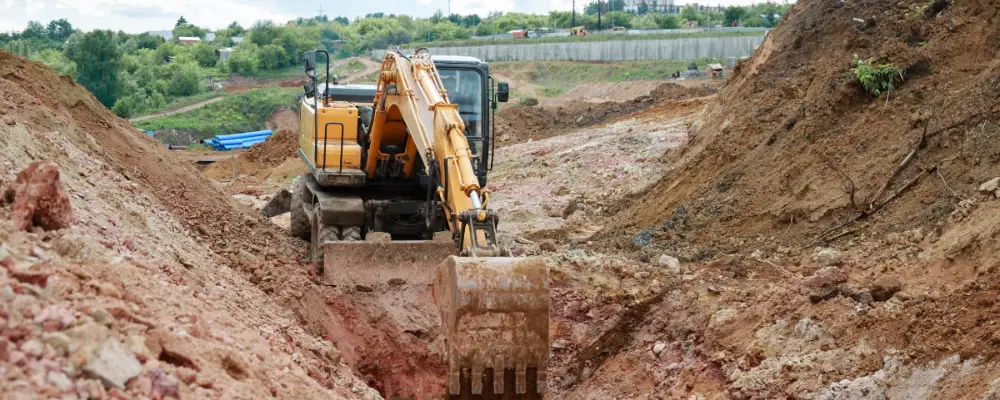Foundations are one of the important parts of the building, that play a major role in binding the structure to the soil. They transfer the loads of the building to the soil and play a major role in holding a structure in place. Numerous types of foundations are laid in the construction industry, among which trench-fill foundations are one of the simplest and most widely used foundation types. Here we take a look at what is a trench filling or trench filling foundation, its construction process, pros, cons, and more.
What is a Trench Filling?
Trench filling is a shallow foundation in which a linear trench is excavated at the ground level and filled with concrete to make it a hardcore foundation for the building. The perimeter of the foundation is based on the dimensions of the proposed building. This is quite similar to a strip foundation, but it eliminates the need for bricklaying below the ground surface.
Importance of Trench Filling
Trench fill foundation is one of the simplest and basic types of foundation. They require less excavation, and constructing them is very quick and straightforward. They are suitable for all types of soil, no matter how loose the soil is or how high the water table is. They are fairly inexpensive and are a wise choice for many low-budget domestic building projects.
Advantages and Disadvantages of trench filling
Advantages
- They are quick and easy to construct within a short period of time.
- They require minimal excavation compared to other types of foundations.
- They are suitable for all types of soils and can accommodate and fulfill various loading requirements.
- These foundations don’t require any complicated or costly formwork before filling.
Disadvantages
- Trench-fill foundations require a lot of concrete to fill the trench, which could increase the cost of construction.
- As no reinforcements are used, they are unsuitable for large-scale buildings or structures requiring high load-bearing capacity.
- If the foundations are not designed or constructed properly, they could lead to cracking and other structural problems.
Mechanism of Trench Foundations
- The ground conditions should be analysed before the trench foundations are laid. Although it is suitable for all types of soils, special consideration should be given to soils that possess frost, shrinkable, and volume-changing characteristics.
- If the ground is found to be hazardous, the NHBC should be notified in advance.
- Dead loads and imposed loads should be calculated before deciding the width and depth of the trench.
- The trench’s depth should not be less than 1 m or above the frost level.
- The width of the trenches should be 50 mm more than the supporting wall on either side.
- The concrete used to fill the trenches should be water-resistant and should withstand freezing and thawing.
- The trench should not possess any moisture and water content, as it may affect the stability of the structure.
- After the concrete is poured, the foundation should be kept idle to harden it with periodical curing using water.
- After the foundation gains the necessary strength and stability, the foundation can be used for the construction process.
Depth of Trench Fill Foundations
Factors that decide the depth of the trench-fill foundation include:
- Strength & composition of soil- A soil test is conducted by a geotechnical engineer to find out the strength and composition of the soil.
- Weight of the building- The weight of the building plays a major role in deciding the depth of the foundation. An architect or structural engineer provides the necessary information by calculation before the trench fill foundation is laid.
- Width of the foundation- The width of the foundation should be equal to or greater than the width of the supporting wall.
- Frost line depth- It is the depth up to which the ground freezes during winter. The frost line depth is analysed and the foundation is laid below it to prevent the damage caused by freezing and thawing.
Step-by-step trench-filling process
- Dig a trench at an appropriate depth and perimeter based on the construction needs and remove any standing water from the trench.
- Prepare concrete by taking the appropriate amount of cement, gravel, sand, and additives like fly ash and mix it with water to form a mixture suitable for the trench filling. It is important to note that the concrete mix should be water-resistant.
- Fill the trenches with concrete using trenchers and compactors before adding each layer to make the trench more dense and stable to withstand the weight of the building. No reinforcements or formwork are used.
- Keep the foundation idle to harden it and cure it with water for an appropriate time.
- After the foundation acquires the necessary strength, it is then ready to hold the building load.
Cost of the trench filling
The cost of any construction project depends upon various factors including the location, size of the trench, materials used, labor cost, economy, and more. Trench filling usually saves costs on formwork and reinforcements; however, it consumes more money due to the concrete used for filling.
Conclusion
Trench filling is one of the most simple and effective ways to construct a foundation that is suitable for almost all soil types. The construction process is easy and doesn’t require any complicated procedures, as the usage of reinforcements and formwork is neglected. They are suitable for small-scale domestic projects that carry a minimal load and buildings up to two floors.

